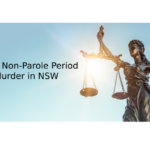Constructive Murder in NSW: Homicide That Occurs During Another Serious Criminal Offence

At about 12.30 am on 24 May 2020, a man referred by the NSW Supreme Court as DPD and four other men, DJD, EE, Murdoch and Shillingsworth, were driving towards the home of Kevin Kourtis, which was located on Langton Street in the Sydney suburb of Quakers Hill.
Over recent months, DPD had been frequenting this house and had even gotten into disputes with Kourtis over the price of the drug ice.
With the lower halves of their faces concealed, the five men gained entry via knocking at the door then forcing their way in. DPD was the first in, and he was holding “a .22 calibre 250 Remington savage model repeating bolt action rifle”, whilst an accomplice was carrying a 30 cm-long knife.
Kourtis was forced into the kitchen by four of the men, whilst EE stood over the victim’s partner, Ms Howlett, who was in the loungeroom.
In the kitchen, one man started asking Kourtis where “the stuff” was but this question went unanswered, so the men physically assaulted their victim, knocking out two of his teeth, and then at least one of them stabbed Kourtis repeatedly, which resulted in his death. But later in court, the prosecution could not establish the identity of the person who stabbed the deceased beyond reasonable doubt.
DPD and another man then went upstairs to the room of Kourtis’ housemate Ulaan McKenzie, who instantly recognised DPD, and he pointed the rifle at her. Then, during a brief altercation between the pair, McKenzie experienced a sharp pain in her right check, and she was not sure whether it was produced by being hit with the rifle or pushed against the doorframe.
Two other men still downstairs were unsuccessful in finding any further information from Ms Howlett about where “the shit” was, and the five men subsequently fled the premises, fearing the NSW police would soon arrive at the scene, and the perpetration of the entire “joint criminal enterprise” took place over the course of about five minutes.
Constructive murder
DPD pleaded guilty to the offence of murder, contrary to section 18(1)(a) of the Crimes Act 1900 (NSW), and he delivered this plea prior to his matter being listed for trial or being arraignment before the NSW Supreme Court.
DPD pleaded guilty to the murder on the basis that he was liable for what is known as ‘constructive murder’, which is when a killing takes place due to an act or omission by the accused, “during or immediately after the commission, by the accused, or some accomplice with him or her, of a crime punishable by imprisonment for life or for 25 years”.
Known in the United States as ‘felony murder’, a constructive murder doesn’t require the perpetrator to have intended to kill the deceased. Nor does it require the intent to commit grievous bodily harm against them. This is different to any other murder which requires proof beyond reasonable doubt of at least one of those things.
The maximum penalty for constructive murder is up to life imprisonment, which is the same as all other forms of murder.
A standard non-parole period (SNPP) applies to the offence of murder, which is 20 years. An SNPP is a reference point or guidepost for a sentencing judge when determining the minimum time a person must spend behind bars before being eligible to apply for release on parole.
However, as DPD was under the age of 18 at the time of offending the SNPP did not apply to him, as the scheme does not apply to minors in general. Although, minors who commit murder in NSW still face a maximum penalty of life imprisonment. And the Office of the Director of Prosecutions takes over investigations of “serious children’s indictable offences” in place of the NSW police.
The sentencing process
The defendant further requested that NSW Supreme Court Justice Robertson Wright take two further offences into account when sentencing him for murder on a Form 1.
Under section 32 of the Crimes (Sentencing Procedure) Act 1999 (NSW), charges which have been laid against an accused but they’ve not been convicted in regard to can be considered on sentencing for a principal offence they have been convicted over, if the defendant requests this occurs. And if this does take place, these offences are said to have been placed on a Form 1.
The two extra offences involved one count of shortening a firearm, contrary to section 62 of the Firearms Act 1996 (NSW), which is a crime that carries up to 14 years prison time, and the second offence involved common assault, under section 61 of the Crimes Act, and it carries up to two years in gaol and/or a $5,500 fine.
On 5 May 2023, Justice Wright sentenced DPD to 15 years and 3 months prison time and non-parole was set at 10 years and 3 months. This reflected a 17.5 percent sentencing discount granted for the utilitarian value of the offender’s early guilty plea.
His Honour also noted on sentencing that DPD was convicted and sentenced over a murder that one of four offenders potentially dealt the fatal blow in regard to. And DPD’s constructive murder was assessed as being “within the middle range” of objective seriousness.
Justice Wright also found “special circumstances” based on DPD’s youth and mental health, which meant he could spend more time on parole than is required by the legislation. Section 44 of the Crimes (Sentencing Procedure) Act 1999 (NSW) stipulates that a parole period must not exceed a third of the time an offender has to remain behind bars, unless special circumstances are found.
Appealing duration of sentence
DPD then appealed his sentenced to the NSW Court of Criminal Appeal (NSWCCA) on 28 April 2025, and he did so based on three grounds.
These comprised of the judge being in error in his assessment of the objective seriousness of the crime, that he’d failed to consider that DPD’s sentence was partially accumulative with another sentence he was serving in terms of the finding of special circumstances and the third ground of appeal arose through a “grievance as a result of disparity of sentence”.
In terms of making an error in assessing the seriousness of the crime, DPD argued that the justice had sentenced him not in accordance with the agreed facts, which at one point had suggested that the deceased was killed by “an accomplice” of DPD, although it also stated the victim was “stabbed multiple times by at least one of the four men”.
But NSWCCA Justice Derek Price found that the sentencing judge did not have to sentence in accordance with the agreed facts, and rather he’d based his assessment of the crime on the basis of the content presented by both the prosecution and defence during the sentencing proceedings. So, this ground was dismissed.
As for whether there was an issue with the partial accumulation of the sentence being handed down with a prior sentence already being served, this ground was neither made out, because the offender’s lawyer had raised a number of reasons why special circumstances should be found, of which the justice agreed and addressed, yet this extra point was not raised by the defence earlier on.
However, as for the question of parity, there was a legitimate reason why this ground should have been and was made out, which involved DPD’s head sentence prior to discount being “18 years and 6 months whereas for EE, the undiscounted starting point was 12 years and 6 months”, and this “difference of 6 years”, Justice Price found, engendered “a justifiable sense of grievance”.
The principle of parity requires that cases that are similar to each other should be treated in a similar manner in terms of punishment. So, the principle should avoid substantial disparity between the sentences of co-offenders involved in the same criminal activity, where they have similar subjective factors.
Quashed and resentenced
On 25 May 2025, Justice Price ordered that the original sentence handed down to DPD by the NSW Supreme Court on 5 May 2023 be quashed, and his Honour then resentenced the inmate to a period of 13 years and 7 months, with non-parole set at 9 years, which reflected the original sentencing discount of 17.5 percent.
NSWCCA Justices Richard Cavanagh and Dina Yehia agreed with their colleague’s findings.








